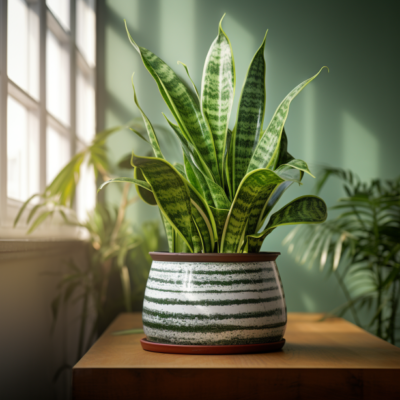According to gardening expert Jane Smith, “Snake plants are very easy to propagate through splitting. Simply separate offshoots from the mother plant with a clean, sharp knife.”.
Known for being nearly impossible to kill, snake plants are good for both beginners and experienced green thumbs.
Splitting your snake plant is a simple way to multiply your greens without much effort.
When your snake plant has developed a few healthy shoots at the base, gently separate the rhizomes connecting the plantlets.
Now you’ll have fully-formed mini snake plants ready to develop in their own pots.
Keep reading to discover how to ensure your split snake plants take root in their new homes.
KEY TAKEAWAY
- Splitting a snake plant is an effective method of propagation, allowing you to expand your greenery with ease.
- Ensure success by choosing a healthy snake plant, using the right tools, and providing proper care post-splitting for optimal growth.
Unlocking the Secrets of Splitting Snake Plants
Snake plants can really thrive when you split them up (1)!
These plants, also known as Sansevieria trifasciata, tend to get big and bushy over time.
Before you know it, your single snake plant will fill up its whole pot.
That’s why it’s important to divide snake plants every now and then.
By splitting the root ball and planting pieces separately, you can end up with more snake plants to enjoy!
Splitting snake plants gives you more room to grow.
These sturdy plants will continue getting bigger year after year if left alone.
Once a snake plant fills its container, its growth might slow down.
By dividing the root system between new pots, each section can stretch out again without being pot bound.
You’ll also want to split snake plants to keep them looking their best.
Overgrown snake plants might start dropping lower leaves or seeing less upright growth.
Dividing into multiple smaller plants is an easy way to perk them back up.
The pieces will put out fresh leaves and stems with renewed vigor in their new homes.
Step-by-Step Guide: How to Divide Your Snake Plant
- Pick a time to repot. Early spring or late summer are good times when plants are actively growing.
- Gently remove the snake plant from its pot. Try not to damage the root ball too much.
- Split the root ball apart by hand. Search for natural gaps between root sections and prise them apart. A sharp, clean knife can also help split tougher root balls.
- Pot up individual sections separately. Use a well-draining potting mix for snake plants. The roots should sit just below the soil line.
- Water new plants sparingly until established. Place pots in indirect light and avoid overwatering, which can cause root rot.
- Check on the plants weekly. Keep the soil slightly moist but not soggy wet. Look for new leaves as a sign of healthy growth.
- Replant sections that are not sprouting within a month. There may have been rot or damage that needs a fresh start.
- Fully rooted plants can be repotted to larger containers as needed. Snake plants prefer to be somewhat pot bound.
- Consider splitting mother plants every 2-3 years or when very root bound to keep them looking their best.
- Enjoy propagating snake plants this easy way and sharing cuttings with family and friends!
Ensuring Success: Care Tips for Newly Divided Snake Plants

Taking good care of snake plants (2) after dividing them is important.
A bit of TLC will help the pieces thrive.
Water them lightly at first.
Newly cut snake plants need time to grow new roots.
Too much water can easily cause root rot.
It’s best to water sparingly from below until active new growth occurs.
Give divided snake plants access to bright, indirect sunlight.
They don’t care for direct sun, which could scorch leaves.
But low light won’t do either.
Aim for a spot with filtered sunshine a few hours daily.
Select a well-draining cactus or succulent soil mix.
Snake plants like soil that dries quickly between waterings.
Use a pot with drainage holes to prevent soggy roots.
You can also add perlite or sand to regular potting soil for improved drainage.
Be patient during the slow growing season.
Don’t fret if plants seem unchanged after a few weeks.
Snake plants are slow growers, especially when first establishing separated pieces.
New roots need time to form before vigorous top growth happens.
Come spring and summer, growth should really take off given ideal care conditions.
Propagate with Confidence: 3 Ways to Multiply Snake Plants

Snake plants can be increased through water propagation, soil propagation, or division.
Water propagation uses leaves, while soil propagation employs root cuttings.
All work but have different pros.
Leaves root in water surprisingly fast, and don’t require a parent plant loss.
However, this method produces non-variegated clones lacking maturity.
Soil propagation keeps color but needs root segments from an existing plant.
Division makes multiple complete new plants directly.
Soil propagation may yield the best variegated results.
Select 4-6 inch root pieces, let cut ends callus, and plant vertically with minimal sun.
Water root cuttings sparingly like a succulent.
Division ensures structural integrity if preferring full healthy divided plants right away.
Whichever method, diligent care means soon having more snake plants to love!
Troubleshooting: Common Issues in Snake Plant Propagation
Propagating snake plants doesn’t always go perfectly smooth.
Here are a few common issues to watch out for:
Leaves planted in soil won’t root.
Snake plants grow roots from cuttings, not leaves.
Try planting only stem and root segments instead.
Pieces take forever to start growing.
Be patient! Snake plants usually grow slow already, and new starts need time to regrow roots before leaves.
Don’t lose hope till 6 months pass.
The “baby” plant looks limp and pale.
It may not be getting enough sun.
Shift to a spot with a few hours bright, indirect light each day.
Lower leaves keep browning off cuttings.
They likely don’t have proper drainage.
Repot in a terra cotta pot with drainage holes using a well-draining cactus soil mix.
Mushy brown stems form on leaves in water.rot has set in from too much water.
Disinfect garden shears and trim away rotted areas before allowing cuttings to callus and replanting.
With little effort, most common issues can be resolved and your propagated snake plants put on the path to sturdy growth!
Repotting and Dividing: Maximizing the Health of Your Snake Plants
Snake plant health greatly benefits from judicious repotting and dividing.
This not only controls their size but boosts the entire root system.
As a snake plant’s roots fill out its pot year after year, growth may slow down due to being root bound.
It needs more room!
While snake plants tolerate small pots, repotting into a slightly larger container every 2-3 years keeps them vigorously popping out fresh foliage.
Dividing also gives all new sections more space to stretch out.
When repotting, first remove the snake plant carefully from its current pot.
Untangle and loosen the root ball if needed using garden shears.
After repotting individual root pieces separately in fresh potting mix, the new plants all perk up thanks to freed up root space!
Well-drained soil is important too for keeping cuttings and your long-term houseplants healthy, happy, and growing strong for many more years to come.
Preventing Splitting Woes: Tips for Healthy Snake Plant Leaves

Splitting leaves on snake plants aren’t a good look.
Fortunately, there are things you can do to keep leaves in tip top shape.
One cause of splitting is inconsistent watering.
Like most succulents, snake plants prefer their soil to dry out between waterings.
Another cause is leaving plants root bound too long in small pots.
Their root growth becomes cramped and causes stress.
A larger container allows for easier root growth to support above growth.
The best time to increase pot size is in spring or summer as roots are actively growing.
Gently pull the main plant from its current pot and loosen any tangled or circling roots.
Repot into fresh soil using a container just 2-4 inches larger.
Give it extra time to acclimate before regular watering.
Snake plants also do better with well-draining soil blends containing ingredients like perlite or peat moss.
Their natural habitat is dry, rocky areas so a loose, fast drying mix prevents overwatering issues.
Lastly, watch for leaves splitting in varieties prone to it, like curly or plain edged types.
These may require extra care.
Moving distressed leaves to a spot with only a few hours bright, indirect light each day helps prevent further damage too.
A little know-how keeps snake plants as handsome and sturdy as their reputation!
Frequently Asked Questions
How do I propagate snake plants using propagate snake plants?
Propagate snake plants can be done very easily by using leaf cuttings or snake plant cuttings.
Simply take a healthy leaf cutting and place it upright in a potting mix.
Keep the soil lightly damp as it establishes new roots.
Within a few months you should see new growth emerging from the cutting as it takes root.
How do I take snake plant cuttings for propagation?
To take snake plant cuttings for propagation, select a leaf that is at least 6 inches long from a healthy mother in law’s tongue or dracaena trifasciata plant.
Use clean garden knife or scissors to cut just below a leaf node on the stem.
Remove the plant from its pot and gently shake or brush away excess soil from the roots.
Replant the rooted cutting in a small plastic pot with well-draining cactus mix or succulent mix.
Place in bright indirect sunlight and allow the soil to dry out between waterings.
New growth should emerge within a few months.
When should I repot my snake plant?
It’s best to repot your snake plant when you notice it has outgrown its current pot.
Signs it needs repotting include the bottom of the pot looks packed with roots, or the soil has become loose.
Carefully remove the plant from the pot and tease the roots if they have become pot bound.
Repot into a slightly larger plastic pot using fresh well-draining cactus or succulent mix.
Return to its spot in bright indirect light and resume regular care.
Avoid repotting too frequently as snake plants do not like their roots disturbed.
How do I care for a snake plant/dracaena trifasciata as an indoor plant?
Snake plants, also known as mother in law’s tongue or dracaena trifasciata, are very easy to care for as indoor house plants.
Provide them with bright indirect sunlight near an east or west-facing window.
Allow the top inch of soil to dry out between waterings, being careful not to overwater.
Use a well-draining potting mix like cactus or succulent soil and ensure the pot has a drainage hole to prevent root rot from excess water.
Water just enough to moisten the soil, then allow it to dry before watering again.
Snake plants are very tolerant of lowlight and infrequent watering so they make great plants for beginners or busy households.
Why are the leaves on my snake plant turning yellow?
Yellowing leaves on a snake plant can be caused by overwatering, underwatering, or needing to be repotted.
Check the soil – if it remains constantly moist or soggy, the roots likely have been getting too much water and are starting to rot.
On the other hand, if the soil is bone dry, the plant may be suffering from lack of water.
Another possibility is the plant has outgrown its pot and needs to be repotted in a slightly larger container using fresh draining soil.
Ensure proper watering and drainage going forward to restore your snake plant’s vibrant green leaves.
Can I propagate my snake plant by placing cuttings in water?
Yes, it is possible to propagate your snake plant by placing cuttings directly in water.
Take healthy 6 inch leaf cuttings as mentioned above and remove the bottom couple inches of the leaf.
Place the cutting upright in a glass or vase of water, making sure the base of the leaf is submerged but not the growing tip.
Keep the water topped up as needed and place it in bright indirect light.
Roots should start to form within 1-2 months.
Once an established root system is present, the new plant can be potted up in soil.
Check the water every few days to ensure it remains clear and change as needed.
Conclusion
Splitting snake plants is a clever way to multiply your houseplants.
Through dividing, root sections are given space to grow outward again in their own pots.
When performed properly, this technique keeps snake plants vigorously popping out fresh foliage for many happy years indoors.
With a bit of care adjusting watering habits and ensuring pot size stays appropriate, newly divided pieces thrive and settle into beautiful specimens.
It’s not too difficult to comprehend either the natural signs that a snake plant is prepared to divide, like pot bound roots.
Nor is the basic process of splitting the root ball apart by hand.
Following a few propagation best practices like steady indirect light and fast-draining soil can make all the difference between success and failure.
With the right know-how, even novice plant parents find themselves with more snake plants to liven their home.
Thanks for reading about my experiences propagating and splitting these sturdy succulents!
If you have any other questions after trying it yourself, I’d love to hear about your results in the comments.
May your snake plants continue bringing you years of enjoyment.
References
- https://www.bhg.com/gardening/houseplants/care/propagate-snake-plant/#:~:text=Divide%20a%20snake%20plant.&text=Begin%20by%20removing%20the%20entire,a%20container%20with%20drainage%20holes.
- https://en.wikipedia.org/wiki/Dracaena_trifasciata
Related Articles
- https://knowngarden.com/dividing-snake-plant-pups-no-crowd-in-a-pot/
- https://knowngarden.com/ways-to-fix-broken-snake-plant-leaves-2021/
- https://knowngarden.com/how-to-trim-snake-plant-superb-tips-2021/




